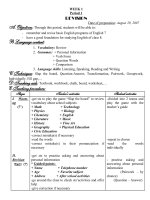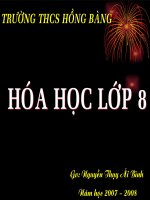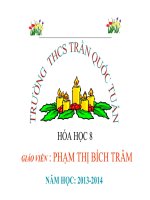unit 8 bài 3
Bạn đang xem bản rút gọn của tài liệu. Xem và tải ngay bản đầy đủ của tài liệu tại đây (177.52 KB, 22 trang )
Date of preparing : October 1
st
2008
Date of teaching : October 2
nd
2008
Period 12
UNIT 3: AT HOME
Lesson 1: Getting started + Listen and Read
A. Objectives: By the end of the lesson, students will be able to:
- talk about the chores they do at home
- describe situations and positions of things
- give advice
B.Language content:
1. Vocabulary: (n) chores, steamer, saucepan, frying pan, rice cooker,
stove
2. Grammar: * Reflexive pronouns
* Modal verbs: must, have to, ought to
* Preposition of position
3. Language skills: Listening, Speaking, Reading and Writing
C.Techniques: Brainstorming, Network, Presentation picture, Picture drill, Question-
Answer, Presentation dialogue, Dialogue drill, Play role, Listing, Mime, What and
Where, Pairwork, Groupwork,…
D.Teaching aids: Textbook, tape, cassette player, chalk, board, …
E.Teaching procedure:
Teacher’s activities Students’activities
I. Warm-up
-get sts to remind the form of writing a
telephone message
-ask sts to present Lisa’s message for
Nancy
-give necessary correction
II. New lesson
1. Presentation
-remind (Individually)
-write the message on the board
-tell the chores they do at home (look at
the pictures in the textbook for help)
-ask sts to tell the chores they do at home
Do the washing up
-encourage sts to speak
-introduce the dialogue between Nam and
his mother, Mrs. Vui
-ask sts some elicited questions
1/ Why is Mrs. Vui going to be home late
tonight?
2/ What will Nam have to do?
-supply the new words
* steamer (n): (Pic)
* saucepan (n): (Pic)
* frying pan (n): (Pic)
* rice cooker (n (Pic)
* stove (n): (Pic)
+ wood stove (n):
+ coal stove (n
+ gas stove (n):
+ electric stove (n):
* yourself (pro): (Explanation)
* ought to + V (bare infinitive):
e.g: You ought to study hard.
-read the words
-correct mistake(s) in their pronunciation
if necessary
-help sts to play the game “What and
Where”
-let sts to listen to the tape and get the
main idea of the conversation between
Nam and his mother
2. Practice
a. Task 1
-get sts to practice the dialogue with a
-listen to the teacher’s introduction
-answer the teacher’s questions with their
understanding (Prediction)
-guess the meaning of the words with the
teacher’s explanation
-take notes
-repeat in chorus
-read the words individually
-play the game with the teacher’s help to
remember the words
-listen to the tape and get the main ideas
(2
(Whole class)
-practice the dialogue
Chores
partner
-go around the class to check sts’work and
offer help
-correct mistake(s) in their pronunciation
if necessary
b. Task 2
-ask sts questions
1/ Where is the rice?
2/ Where is the steamer?
3/ Where is the rice cooker?
-correct mistake(s) if necessary and
remind the prepoisitions of position
* Key:
1/ The rice is in the cupboard.
2/ The steamer is under the sink, between
the saucepan and the frying pan.
3/ It is beside the stove.
c. Task 3
-ask sts to read the dialogue again and
make a list of things Nam has to do
-go around the class to check sts’work and
offer help
-give necessary correction
* Key:
+ cook dinner
+ go to the market to buy some fish and
vegetables
+ call aunt Chi and ask her to meet his
mother at Grandma’s house
3. Production
-ask sts question about themselves
1/ What do you often do when your
parents are out?
2/ Do you often go to the market? If yes,
what do you often buy at the market?
-encourage sts to speak about themselves
and give necessary correction
-educate sts to help their parents to do the
chores at home
(Pairwork + Play role)
-present the dialogue before the class (3
pairs)
-read the dialogue again and answer the
questions
(Individually)
-listen and remember or take notes if
necessary
-read the dialogue again and make a list of
things Nam has to do (Groupwork)
-write the list of things Nam has to do on
the board
-answer the teacher’s questions
(Individually)
III. Consolidation
-summarize the lesson (remind the chores
and what sts ought to do) -listen and remember
-listen and remember
(Whole class)
IV. Homework: Learn by heart the new words and read the dialogue fluently.
- Prepare “Speak + Language focus 4
F. Self - valuation:
………………………………………………………………………………………………
………………………………………………………………………………………………
…….
………………………………………………………………………………………………
………………………………………………………………………………………………
…….
…………………………………………….…………………………………………
…
Date of preparing : October 2
nd
2008
Date of teaching : October 3
rd
2008
Period 13
UNIT 3: AT HOME
Lesson 2: Speak + Language focus 4
A. Objectives: By the end of the lesson, students will be able to:
- describe situations and positions of things
- arrange the things in a room/tidy up the room
- review questions with “Why” and answers with “Because”
B.Language content:
1. Vocabulary: (n) items in the house
Calendar, dishrack, wall, ceiling, rug, cushion
2. Grammar: * Prepositions of position
* Why - Because
3. Language skills: Listening, Speaking, Reading and Writing
C.Techniques: Question-Answer, Listing, Presentation picture,Brainstorming,Picture
drill, Hide and seek in the picture, Pairwork, Groupwork,…
D.Teaching aids: Textbook, picture, chalk, board, …
E.Teaching procedure:
Teacher’s activities Students’activities
I. Warm-up
-get sts to tell the chores they often do at
home
-give necessary correction
II. New lesson
1. Speak
a. Presentation
-introduce the aim of this part (Speaking
lesson)
-ask sts to look at the picture on page 28
and identify the positions of the items in
the picture
-help sts review the prepositions of
position
-supply more if necessary
* Prepositions of position: in, on, under,
next to, near, between, above, in front of,
behind, in the middle of, …
-supply necessary words for speaking
* wall (n): (Realia + Mime)
* calendar (n): (Realia)
* dishrack (n): (Picture)
* lighting fixture (n): (Picture)
* ceiling (n): (Mime + Realia)
* counter (n): (Picture)
-read the words
b. Practice
-get sts to look at the picture and talk
about the position of each item
-go around the class to check sts’work
and offer help
-give necessary correction (encourage sts
-tell the chores they often do at home
(Individually)
-listen to the introduction
(Whole class)
-look at the picture on page 28 and identify
the positions of the items in the picture
-remind the prepositions of position
(Individually)
-take notes
-guess the meanings of the words with the
teacher’s explanation
-take notes
-repeat in chorus
-look at the picture and talk about the
position of each item
(Groupwork)
-present before the class
to speak)
* Suggested answers:
+ The clock is on the wall, above the
calendar.
+ The calendar is on the wall, between
the clock and the fridge.
+ The sink is next to the stove.
+ A saucepan and two frying pans are
above the stove.
+ The knives are under the cupboard.
+ The rice cooker in on the counter.
c. Production
-get sts to look at the picture of Mrs.’s
Vui living-room and explain the
requirement (Mrs. Vui bought new
furniture for her living-room, but she
cannot decide where to put it)
-get sts to remind the meanings of the
words in the box
* rug (n): (Picture)
* cushion (n): (Picture)
-read the words in the box
-have sts help Mrs. Vui arrange the
furniture
(explain the examples)
-go around the class to check sts’work
and offer help
-correct mistake(s) if necessary
(encourage sts to speak)
* Suggested answers:
1/ Let’s put the cushions on the couch.
2/ I think we should put the coffee table
between the couch and the armchair.
3/ Let’s hang the clock on the wall,
above the picture.
4/ I think we should put the telephone
and the lamp on the small table next to
the shelf.
5/ Let’s put the magazines on the shelf
above the books.
-look at the picture and listen to the teacher’s
explanation
-remind the meanings of the words in the
box
-take notes
-repeat in chorus
-arrange the furniture
(Groupwork)
-present before the class
2. Lang. focus4
a. Task 1
-get sts to remind the meanings and the
usages of “Why” and “Because” (for
asking and answering about the
reasons)
-make the example clearer
-get sts to look at the pictures in the
textbook to ask and answer about Hoa,
Nam, Mrs. Vui, Ha and Nga suitably
-go around the class to check sts’work
and offer help
-give necessary correction (encourage sts
to speak)
* Key:
b/ Why did Nam have to cook dinner?
Because his mother was home late.
c/ Why was Mrs. Vui home late?
Because she had to go to visit her
mother.
d/ Why did Ha fail her English exam?
Because she didn’t learn for her
exam. She played video games too
much.
e/ Why didn’t Nga go to the movies?
Because she had to do her chores.
b. Task 2
-ask sts some questions
1/ Why do you study English?
2/ Why do you sweep the floor every
day?
-give necessary correction (encourage sts
to speak)
III. Consolidation
-summarize the lesson
* remind the ways to talk about the
positions of the items
* remind the ways of asking and
answering about the reasons
-remind the meanings and the usages of the
two words
-pay more attention
-look at the pictures in the textbook to ask
and answer about Hoa, Nam, Mrs. Vui, Ha
and Nga
(Pairwork + Question-Answer)
-present before the class
-take notes
-answer the teacher’s questions
(Individually)
-listen and remember
(Whole class)
IV. Homework:
- Write the position of each item in the picture on page 28 in the exercise
notebook.
- Do exercise 6 on page 25 (Workbook)
- Prepare “Listen + Language focus 1”
F. Self - valuation:
………………………………………………………………………………………………
………………………………………………………………………………………………
…
………………………………………………………………………………………………
………………………………………………………………………………………………
…….
………………………………………………………………………………………………
………………………………………………………………………………………………
…….
…………………………………………….…………………………………………
…
Date of preparing : October 5
th
2008
Date of teaching October 7
th
2008
Period 14
UNIT 3: AT HOME
Lesson 3: Listen + Language focus 1
A. Objectives: By the end of the lesson, students will be able to:
- know to make special Chinese fried rice
- develop their listening comprehension skills
- talk about the duty with “must” and “have to”
B.Language content:
1. Vocabulary: (n) fried rice, garlic, onion, green pepper
Fish tank
(v) empty the garbage, tidy, dust
2. Grammar: * must – have to
3. Language skills: Listening, Speaking, Reading and Writing
C.Techniques: Question-Answer, Hide and seek in the picture, Brainstorming,
Presentation picture, Prediction, Picture drill, Fill gap, Dialogue drill, Play role, Pairwork,
Groupwork,…
D.Teaching aids: Textbook, picture, tape, cassette player, chalk, board, …
E.Teaching procedure:
Teacher’s activities Students’activities
I. Warm-up
-use the picture on page 28 and guide sts
to play the game “Hide and seek in the
picture”
with the questions:
Where is the clock?/ the sink?/ the
lighting fixture?/ the vase of flowers?
-give necessary correction (encourage sts
to speak)
II. New lesson
1. Listen
a.Pre-listening
-introduce the aim of the listening lesson
(how to make special Chinese fried rice)
-get sts to look at the pictures on page 30
and identify the items in the pictures
a
/
rice noodles
b
/
a
saucepan
a frying pan
c
/
- garlic
- onion
- garlic
- green
pepper
d
/
- chicken
-pea
- ham
- pea
b.While-listen
-ask sts “What do you need to cook the
special Chinese fried rice?”
-let sts listen to the tape and choose the
right item
-let sts listen to the tape again for checking
c.Post-listening
-correct mistake(s) if necessary by letting
sts listen to the tape again and pausing at
-look at the picture and answer the
teacher’s questions
(Individually)
-listen to the teacher’s introduction
-look at the pictures on page 30 and
identify the items in the pictures (Whole
class)
-present before the class
-give their own ideas/ give their prediction
-listen to the tape and choose the right item
-compare with their friends
-listen to the tape and check their answers
-present before the class
what is necessary
* Key:
a/ fried rice b/ pan
c/ garlic and green pepper
d/ ham and pea
2.Lang.focus1
a.Presentation
-ask sts some questions
1/ What do we need to cook the “Special
Chinese fried rice”?
2/ Do you often cook this food?
-encourage sts to speak
-introduce the aim of this part
-get sts to remind the meaning and the
usage of “must/ have to”
* We use must and have to to say what is
necessary to do
*
-tell sts to give examples
-talk about the difference between “must”
and “have to”
b. Practice
-ask sts to look at the picture the pictures
on page 34 to identify the activities in the
pictures
-read the verbs in the box
-explain the meanings of the words
* empty the garbage (v): (Pic.)
* tidy (v): (Example + Pic.)
* dust (v): (Mime)
* fish tank (n): (Pic.)
-get sts to complete the dialogue between
Nga and Lan with “must/ have to” and the
verbs in the box
-go around the class to check sts’work and
offer help
-give necessary correction
-answer the teacher’s questions
(Individually)
-listen to the teacher’s introduction
-remind
-take notes
(Whole class)
-give examples
-listen and take notes
-look at the picture the pictures on page 34
to identify the activities in the pictures
-repeat in chorus
-guess the meanings of the words with the
teacher’s explanation
-complete the dialogue between Nga and
Lan with “must/ have to” and the verbs in
the box
(Pairwork)
-present before the class
S + must/ have to + V (infinitive)
* Key:
(1) have to/ must tidy
(2) have to/ must dust
(3) have to/ must sweep
(4) have to/ must clean
(5) have to/ must empty
(6) have to/ must feed
-get sts to practice the dialogue
-correct mistake(s) in their pronunciation
if necessary
c. Production
-get sts to make a survey with the question
“What do you have to do?/ What must
you do?”
-give necessary correction (encourage sts
to speak)
III. Consolidation
-summarize the lesson
+ remind the way how to cook special
Chinese fried rice
+ the meanings and the usages of “have to/
must”
-practice the dialogue
(Pairwork + Play roles)
-make a survey
(Work in group of five sts)
-present before the class
-listen and remember
(Whole class)
IV. Homework:
- Write five sentences to express 5 things that you have to/ must do
- Do exercise 1 on page 20 (Workbook)
- Prepare “Read”
TAPE TRANSCRIPT:
Lan: Can I help you cook dinner, Mom?
Mrs. Tu: Sure. You can cook the “Special Chinese Fried Rice” for me. Use the big pan,
please.
Lan: Okay. How much oil do I put in?
Mrs. Tu: Just a little. Wait until it’s hot and then fry the garlic and the green peppers.
Lan: Do I put the ham and the peas in now?
Mrs. Tu: Yes. And you can put the rice and a teaspoon of salt in.
Lan: Yummy! It smells delicious.
F. Self - valuation:
………………………………………………………………………………………………
………………………………………………………………………………………………
…
………………………………………………………………………………………………
………………………………………………………………………………………………
…….
………………………………………………………………………………………………
………………………………………………………………………………………………
…….
…………………………………………….…………………………………………
…
Date of preparing : October 8
th
2008
Date of teaching : October 10
th
2008
Period 15
UNIT 3: AT HOME
Lesson 4: Read
A. Objectives: By the end of the lesson, students will be able to:
- know safety precautions in the home
- know what they have to do and mustn’t do
- protect themselves and their relatives
- ask for and give the reasons
- develop their reading comprehension skills
B.Language content:
1. Vocabulary: (n) precaution, chemical, drug, match, electrical socket,
bead
(v) make sure, destroy, injure, cause a fire,cover, kill
Keep s.t out of children’s reach
2. Grammar: * must – have to
* Why - Because
3. Language skills: Listening, Speaking, Reading and Writing
C.Techniques: Brainstorming, Presentation text, Prediction, Mime, Question-Answer,
True-False statements, Rub out and remember, Text drill, Pairwork, Groupwork,…
D.Teaching aids: Textbook, picture,Realia, chalk, board, …
E.Teaching procedure:
Teacher’s activities Students’activities
I. Warm-up -give five things they have to/ must do
-get sts to talk about five things they
have to/ must do
-give necessary correction (encourage
sts to speak)
II. New lesson
1. Pre-read
-ask sts
1/ What can be dangerous to young
children in a house?
2/ Which room is the most dangerous
place to them in a house?
-introduce the situation (Lan’s mother,
Mrs. Quyen is at her local community
center. She is reading one of the posters
on the wall)
-supply the new words
* safety (n): safe (a) (Example)
* precaution (n): (Trans.)
safety precaution
* chemical (n): (Realia)
* drug (n) = medicine: (Realia)
* make sure (v): (Trans.)
* match (n): (Realia)
* fire (n): (Picture)
* destroy (v): (Trans.)
* injure (v): (Picture)
* cause a fire (v): (Trans.)
* cover (v): (Mime)
* electrical socket (n): (Realia)
* electricity (n): (Explanation)
* kill (v): (Trans. or Example)
* keep s.t out of children’s reach (v):
* bead (n):
-read the words
-correct mistake(s) in their pronunciation
if necessary
-use the technique “Rub out and
Remember” to help sts remember the
necessary words (italic words)
2. While-read
(Individually)
-think and answer the teacher’s questions
-listen to the teacher’s introduction
(Whole class)
-guess the meanings of the words with the
teacher’s explanation
-take notes
-repeat in chorus (2 times)
-read the words individually
a. Task 1
-get sts to read the poster to get the main
ideas
-ask sts to read the poster loudly before
the class
-correct mistake(s) in their pronunciation
if necessary
b. Task 2
-ask sts to read the poster again and
check True/ False, then correct the false
sentences
-go around the class to check sts’work
and offer help
-give necessary correction
* Key:
b-T
c-F (A kitchen is a dangerous place to
play.)
d-F (Playing with one match can cause
a fire.)
e-T ; f-T
c. Task 3
-get sts to practice asking and answering
the questions of exercise 2 on page 32
-go around the class to check sts’work
and offer help
-give necessary correction
* Key:
b/ Because the kitchen is a dangerous
place to play.
c/ Because playing with one match can
cause a fire.
d/ Because children try to put anything
into electrical sockets. Electricity can
kill.
-read the poster and get the main ideas
-change their ideas with their friends
-read the poster loudly before the class (2 sts)
-read the poster again and check True/ False,
then correct the false sentences
(Groupwork)
-present before the class
-practice asking and answering the questions
of exercise 2 on page 32 (Pairwork)
-present before the class
(Question-Answer + Pairwork)
e/ Because the dangerous pbjects can
injure or kill children if them play with
these things.
3. Post-read
-get sts to tell the safety precaution
they’ve known
-give necessary correction (encourage
sts to speak)
III. Consolidation
-summarize the lesson (remind the
safety precautions)
-educate sts how to protect themselves
and their relatives (how to live safely in
the home)
-tell the safety precaution they’ve known
(Individually)
-listen and remember
IV. Homework:
- Learn by heart the new words and read the poster fluently and carefully.
- Write exercises (1 +2) on pages 31 +32 in the exercise notebook
- Prepare “Write”
F. Self - valuation:
………………………………………………………………………………………………
………………………………………………………………………………………………
…
………………………………………………………………………………………………
………………………………………………………………………………………………
…….
………………………………………………………………………………………………
………………………………………………………………………………………………
…….
…………………………………………….…………………………………………
…
Date of preparing : October12th 2008
Date of teaching : October 14
th
2008
Period 16
UNIT 3: AT HOME
Lesson 5: Write
A. Objectives: By the end of the lesson, students will be able to:
- describe a place
- write a description of a room
- develop their writing skills.
B.Language content:
1. Vocabulary: (n) furniture
A description of a room
2. Grammar: * Present simple tense
* Prepositions of position
3. Language skills: Listening, Speaking, Reading and Writing
C.Techniques: Listing, Brainstorming, Presentation picture, Picture drill, Mime,
Question-Answer, Build a paragraph, Noughts and Crosses, Pairwork, Groupwork,…
D.Teaching aids: Textbook, picture, chalk, board, …
E.Teaching procedure:
Teacher’s activities Students’activities
I. Warm-up
-get sts to list the “safety precautions in the home”
they’ve known
(use the technique “Chain game” if possible)
-give necessary correction (encourage sts to speak)
II. New lesson
1. Pre-write
-introduce the objectives of the lesson (write the
description of the room)
-get sts to look at the picture of Hoa’s room on page
32 to identify the objects in her room and their
positions
-supply the new words
* folder (n): (Realia)
* wardrobe (n) (Picture)
-read the words
-remind the structures
* There is
-list the “safety precautions in the
home”
(Chain game if possible)
-listen to the teacher’s description
(Whole class)
-look at the picture of Hoa’s
room on page 32 to identify the
objects in her room and their
positions
-tell the objects in Hoa’s room
before the class (Individually)
-guess the meanings of the words
with the teacher’s explanation
-repeat in chorus
-take notes
a……………………… on…………………………
.
* There
are……………………… beside…………………
2. While-write
a. Task 1
get sts to read the description of Hoa’s room
-ask sts to look at the picture of Hoa’s kitchen and
identify the objects in it
-get sts to read the words given
-explain the meanings of the new words
* oven (n): (Explanation + Trans.)
* towel rack (n): (Picture)
* jar (n): (Picture)
* flour (n): (Picture)
b. Task 2
-ask sts to use the words and phrases given with the
picture to write a description of Hoa’s kitchen
-go around the class to check sts’work and offer help
-get sts to exchange their paper with other groups
-collect paper and give necessary correction
3. Post-write
-tell sts to write a description of a room in their
houses
-solve the problems to help sts develop their writing
skills
-give the common mistake(s) in sts’writing and
correct it/ them
III. Consolidation
-summarize the lesson (remind the way of writing a
description of a room)
-read the description of Hoa’s
room in silence
-read the paragraph loudly before
the class (1 st)
-look at the picture of Hoa’s
kitchen and identify the objects
in it (Individually)
-read the words given
(Whole class)
-guess the meanings of the words
with the teacher’s explanation
-take notes
-write a description of Hoa’s
kitchen, using the words and the
phrases given with the picture
(Groupwork)
-exchange with other groups
-hand in the paper
-write a description of a room in
their houses, basing on exercise 1
+ 2 (Individually)
(do at home)
-give their problems for the
writing
-listen and remember
(take notes)
-listen and remember
(Whole class)
IV. Homework: Write a description of a room in your house.
- Prepare “Language focus 2 + 3”
The suggested paragraph
This is Hoa’s kitchen. There is a refrigerator on the right corner of the room. Next
to the refrigerator is the stove and oven. On the other side of the oven, there is a sink and
next to the sink is a towel rack. The dishrack is on the counter, to/on the right (side) of
the window and beneath the shelves. On the shelves and on the counter beneath the
window, there are jars of sugar, flour and tea. In the middle of the kitchen, there is a
table and four chairs. The lighting fixture is above the table, and directly beneath the
lighting fixture is a vase of flowers.
F. Self - valuation:
………………………………………………………………………………………………
………………………………………………………………………………………………
…
………………………………………………………………………………………………
………………………………………………………………………………………………
…
………………………………………………………………………………………………
………………………………………………………………………………………………
…
…………………………………………….…………………………………………
…
Date of preparing October 15
th
2008
Date of teaching : October 16
th
2008
Period 17
UNIT 3: AT HOME
Lesson 6: Language focus 2 + 3
A. Objectives: By the end of the lesson, students will be able to:
- express advice
- know how to use reflexive pronouns correctly
B.Language content:
1. Vocabulary: Review
- fix, cry
2. Grammar: * ought to / should
* Reflexive pronouns
3. Language skills: Listening, Speaking, Reading and Writing
C.Techniques: Hide and seek in the picture, Brainstorming, Presentation picture, Picture
drill, Mime, Question-Answer, Fill gap, Noughts and Crosses, Pairwork, Groupwork,…
D.Teaching aids: Textbook, picture, chalk, board, …
E.Teaching procedure:
Teacher’s activities Students’activities
I. Warm-up
-hang a picture (a living-room) on the board
and help sts to play the game “Hide and
seek in the picture”
-give necessary correction (encourage sts to
be self-confident)
II. New lesson
1.Lang.focus2
a. Presentation
-introduce the objective of this part (give
others advice)
-ask sts to remind the way to give other
advice they’ve already learned
* We use “should/ ought to” to express
advice, obligation, probability, responsibility
-get sts to give the formation with “should/
ought to”
-ask sts to give illustrated examples
e.g
1
: Your English is not good. You should/
ought to practice more.
e.g
2
: I don’t feel well.
You ought to stay home.
* Negative form of “ought to” is “ought
not to” or “oughtn’t to”
b. Practice
-get sts to look at the picture on page 35 and
read te situation, then give advice to those
people
-go around the class to check sts’work and
-play the game with the teacher’s guide
(Whole class)
-listen to the teacher’s introduction
-remind the way to give other advice
they’ve already learned
-give the formation
-give illustrated examples
-take notes
-look at the picture on page 35 and read
te situation, then give advice to those
people
(Individually)
-compare with their friends
S + should/ ought to + V
(infi.)
offer help
-give necessary correction (encourage sts to
give their own ideas)
* Suggested advice
b/ You ought to get up earlier.
c/ You ought to eat more fruit and
vegetables./
You ought to have a diet./ you ought not to
eat much meat.
d/ You ought to go to the dentist.
c. Production
-divide the class into 2 team (team A gets the
situations and team B give the advice)
1/ I don’t know how to do this exercise.
2/ My room is very dirty./ Our schoolyard is
very dirty.
3/ We can’t speak English well.
2.Lang.focus3
a. Presentation
-introduce the reflexive pronouns and their
usages
Personal pronouns Relexive
pronouns
(as subjects)
I myself
You yourself/
yourselves
He himself
She herself
It itself
We ourselves
They themselves
* Usages: Reflexive pronouns are used as
objects, for emphasizing
* Notes:
-present before the class
-divided into 2 team and do as the
teacher’s requirement
-listen to the teacher’s introduction
(Whole class)
-form the reflexive pronouns if possible
-take notes
e.g: She made herself fall down. (object)
I wash clothes myself every day.
(empha.)
b. Practice
-explain the requirement of exercise 2
-read the reflexive pronouns in the box
-get sts to complete the dialogue with the
reflexive pronouns in the box (make the
example clearer)
-go around the class to check sts’work and
offer help
-give necessary correction
* Key:
b/ …(1) ourselves.
c/ …(2) myself. …(3)yourself…
d/ …(4) himself…………(5) herself…
…(6) themselves
e/ …(7) yourselves…
-get sts to practice the completed dialogues
-correct mistake(s) in their pronunciation if
necessary
c. Production
-ask sts to complete the sentences with the
suitable reflexive pronouns
1/ Nam loves looking at ………………in the
mirror.
2/ I’m making ………………………a cup of
tea.
3/ Did you paint the
house………………………………?
4/ The cat can open the door
by…………………….?
5/ We enjoyed…………………very much last
night.
-give necessary correction/ key.
III. Consolidation
-listen to the teacher’s explanation
-repeat in chorus
-complete the dialogues
(Pairwork)
-compare with other pairs
-present before the class
(Pairwork + Play role)
-practice the dialogues before the class
-read the sentences and complete them
with the suitable reflexive pronouns
(Individually)
-compare with their friends
-present before the class
-summarize the lesson
+ remind the usages and form of “ought to”/
“should”
+ remind the usages of reflexive pronouns
+ get sts to remind the reflexive pronouns
from the personal pronouns
-listen and remember
-remind the reflexive pronouns from the
personal pronouns
(Whole class)
IV. Homework:
- Learn by heart the refexive pronouns and write 5 sentences with them.
- Write 5 sentences with “ought to”/ “should”
- Do exercises 2 + 3 on pages 20, 21, 22 (Workbook)
F. Self - valuation:









